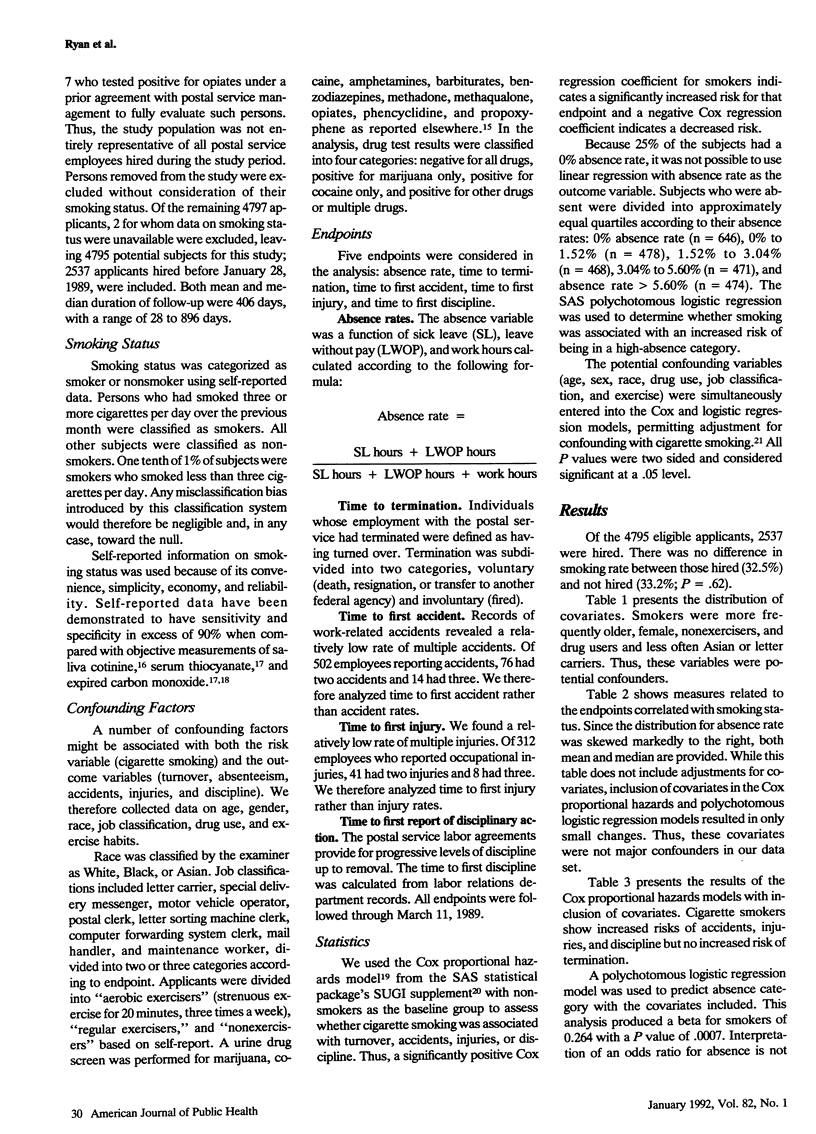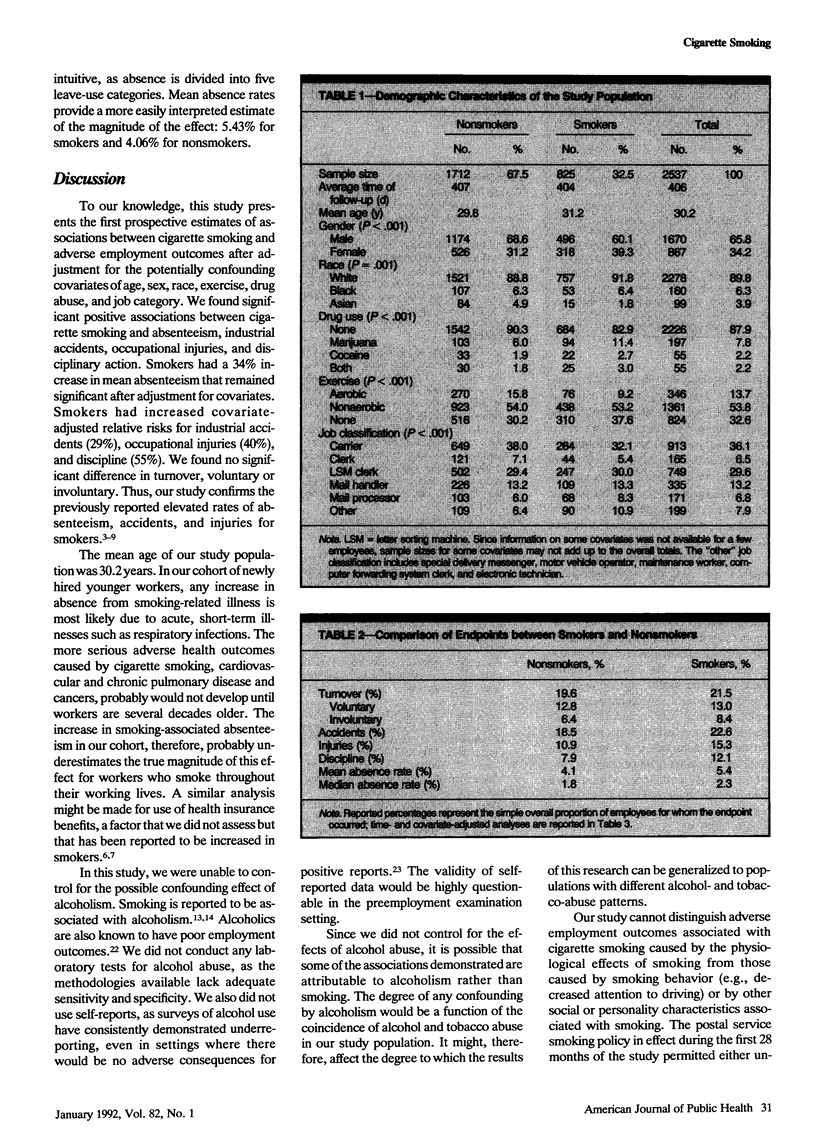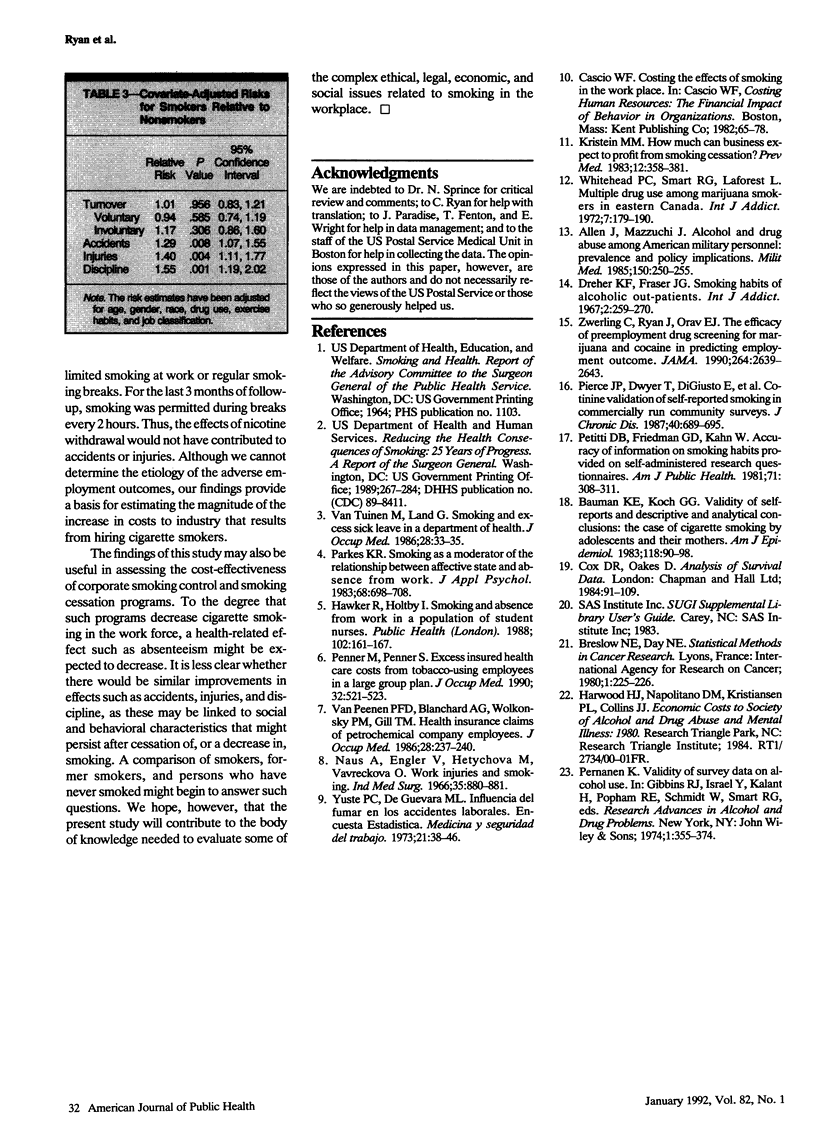Abstract
BACKGROUND. Studies have indicated that cigarette smokers have more occupational accidents and injuries and use more sick time and health benefits than nonsmokers, thereby producing sizeable costs for employers. However, they usually have not controlled for other possible sources of these costs. We analyzed occupational costs associated with smoking while adjusting for a number of potential confounders. METHODS. We conducted a prospective, controlled study of the association between smoking and employment outcomes in 2537 postal employees, adjusting for age, gender, race, drug use, job category, and exercise habits. RESULTS. For smokers, the relative risk for turnover was 1.01 (95% confidence interval [CI], 0.83-1.21); for accidents 1.29 (CI, 1.07-1.55); for injuries 1.40 (CI, 1.11-1.77); for discipline 1.55 (CI, 1.19-2.02). Their mean absence rate was 5.43% compared with 4.06% for nonsmokers. CONCLUSIONS. Our study shows that cigarette smoking is associated with adverse employment outcomes after controlling for a number of possible confounders. This finding has implications for companies formulating smoking policies and considering the establishment of smoking cessation programs.
Full text
PDF



Selected References
These references are in PubMed. This may not be the complete list of references from this article.
- Allen J., Mazzuchi J. Alcohol and drug abuse among American military personnel: prevalence and policy implications. Mil Med. 1985 May;150(5):250–255. [PubMed] [Google Scholar]
- Bauman K. E., Koch G. G. Validity of self-reports and descriptive and analytical conclusions: the case of cigarette smoking by adolescents and their mothers. Am J Epidemiol. 1983 Jul;118(1):90–98. doi: 10.1093/oxfordjournals.aje.a113620. [DOI] [PubMed] [Google Scholar]
- Hawker R., Holtby I. Smoking and absence from work in a population of student nurses. Public Health. 1988 Mar;102(2):161–167. doi: 10.1016/s0033-3506(88)80043-x. [DOI] [PubMed] [Google Scholar]
- Kristein M. M. How much can business expect to profit from smoking cessation? Prev Med. 1983 Mar;12(2):358–381. doi: 10.1016/0091-7435(83)90245-1. [DOI] [PubMed] [Google Scholar]
- Naus A., Engler V., Hetychova M., Vavreckova O. Work injuries and smoking. Ind Med Surg. 1966 Oct;35(10):880–881. [PubMed] [Google Scholar]
- Parkes K. R. Smoking as a moderator of the relationship between affective state and absence from work. J Appl Psychol. 1983 Nov;68(4):698–708. [PubMed] [Google Scholar]
- Penner M., Penner S. Excess insured health care costs from tobacco-using employees in a large group plan. J Occup Med. 1990 Jun;32(6):521–523. doi: 10.1097/00043764-199006000-00008. [DOI] [PubMed] [Google Scholar]
- Petitti D. B., Friedman G. D., Kahn W. Accuracy of information on smoking habits provided on self-administered research questionnaires. Am J Public Health. 1981 Mar;71(3):308–311. doi: 10.2105/ajph.71.3.308. [DOI] [PMC free article] [PubMed] [Google Scholar]
- Pierce J. P., Dwyer T., DiGiusto E., Carpenter T., Hannam C., Amin A., Yong C., Sarfaty G., Shaw J., Burke N. Cotinine validation of self-reported smoking in commercially run community surveys. J Chronic Dis. 1987;40(7):689–695. doi: 10.1016/0021-9681(87)90105-6. [DOI] [PubMed] [Google Scholar]
- Van Peenen P. F., Blanchard A. G., Wolkonsky P. M., Gill T. M. Health insurance claims of petrochemical company employees. J Occup Med. 1986 Mar;28(3):237–240. [PubMed] [Google Scholar]
- Van Tuinen M., Land G. Smoking and excess sick leave in a department of health. J Occup Med. 1986 Jan;28(1):33–35. doi: 10.1097/00043764-198601000-00009. [DOI] [PubMed] [Google Scholar]
- Whitehead P. C., Smart R. G., Laforest L. Multiple drug use among marijuana smokers in eastern Canada. Int J Addict. 1972;7(1):179–190. doi: 10.3109/10826087209026772. [DOI] [PubMed] [Google Scholar]
- Zwerling C., Ryan J., Orav E. J. The efficacy of preemployment drug screening for marijuana and cocaine in predicting employment outcome. JAMA. 1990 Nov 28;264(20):2639–2643. [PubMed] [Google Scholar]


